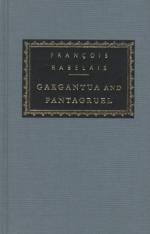On this point much research and investigation might be employed. But there is no need why these researches should be extended to the region of fancy. Gargantua has been proved by some to be of Celtic origin. Very often he is a solar myth, and the statement that Rabelais only collected popular traditions and gave new life to ancient legends is said to be proved by the large number of megalithic monuments to which is attached the name of Gargantua. It was, of course, quite right to make a list of these, to draw up, as it were, a chart of them, but the conclusion is not justified. The name, instead of being earlier, is really later, and is a witness, not to the origin, but to the success and rapid popularity of his novel. No one has ever yet produced a written passage or any ancient testimony to prove the existence of the name before Rabelais. To place such a tradition on a sure basis, positive traces must be forthcoming; and they cannot be adduced even for the most celebrated of these monuments, since he mentions himself the great menhir near Poitiers, which he christened by the name of Passelourdin. That there is something in the theory is possible. Perrault found the subjects of his stories in the tales told by mothers and nurses. He fixed them finally by writing them down. Floating about vaguely as they were, he seized them, worked them up, gave them shape, and yet of scarcely any of them is there to be found before his time a single trace. So we must resign ourselves to know just as little of what Gargantua and Pantagruel were before the sixteenth century.
In a book of a contemporary of Rabelais, the Legende de Pierre Faifeu by the Angevin, Charles de Bourdigne, the first edition of which dates from 1526 and the second 1531—both so rare and so forgotten that the work is only known since the eighteenth century by the reprint of Custelier—in the introductory ballad which recommends this book to readers, occur these lines in the list of popular books which Faifeu would desire to replace:
’Laissez ester Caillette le folastre,
Les quatre filz Aymon vestuz de bleu,
Gargantua qui a cheveux de plastre.’
He has not ‘cheveux de plastre’ in Rabelais. If the rhyme had not suggested the phrase—and the exigencies of the strict form of the ballade and its forced repetitions often imposed an idea which had its whole origin in the rhyme—we might here see a dramatic trace found nowhere else. The name of Pantagruel is mentioned too, incidentally, in a Mystery of the fifteenth century. These are the only references to the names which up till now have been discovered, and they are, as one sees, of but little account.




